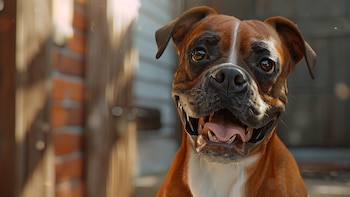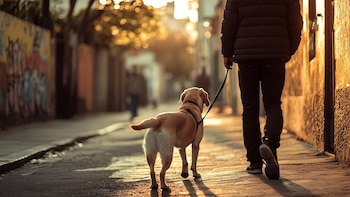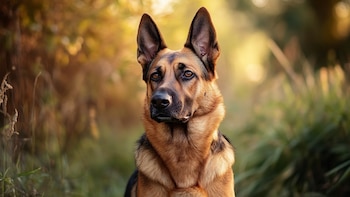





In recent decades, the relationship between dogs and human beings have undergone a radical transformation. What were once hunting companions or tireless watchers, today have become integral members of the family, sharing the sofa and adopting a more sedentary lifestyle. This change has caused scientists to pay attention to a surprising phenomenon: dogs are going through a new evolutionary phase.
According to a study led by Brian Hareprofessor of evolutionary anthropology at the Duke Universityand Vanessa Woodsprogram manager Duke Puppy Kindergartenmodern dogs are showing biological and cognitive adaptations that allow them to better fit into the contemporary world. This study was published in Atlanticwhere both experts are co-authors of Puppy Kindergarten: The New Science of Raising a Great Dog. The results suggest that Dogs, especially those trained as service animals, are developing characteristics that prepare them for life in the 21st century, marking what could be considered a third wave of domestication.
What makes this finding even more significant is how quickly these changes have occurred. In just one generation, humans have changed the rules for their dogs, forcing them to adapt to increasingly urban and less wild environments. How are dogs responding to this change? Scientists believe that the keys to understanding this phenomenon are deeply rooted in the social evolution and the domestication of dogs over thousands of years.

For much of history, dogs were valued primarily for the tasks they could perform. They hunted, guarded the property and helped herd the livestock. These roles required a active prey drivea lot of energy and often a distrust of strangers. Even a few decades ago, dogs were expected to act as guardians of the home, protecting both people and property.
However, the urbanization This scenario has changed. Today, instead of hunting or protecting, dogs have become integrated into families, sharing closed spaces and a much more active lifestyle. sedentary. Americans, for example, no longer look for a dog that barks at every noise. They prefer a companion who can rest under the desk during a remote work day or who is friendly with other animals in the park. “The wild, open places where dogs were once able to roam have been drastically reduced,” says Hare in his research, highlighting how the evolution of environments has had a direct impact on canine behavior.
One of the most important points of Hare and Woods’ study is the comparison between domestic dogs and dogs. service dogs. The latter, often trained to help people with disabilities, are not only more obedient, but also seem to have a level of social cognition superior. They are extremely friendly and, as puppies, show a natural inclination towards human interactions. This trait, which distinguishes them from even the most common domestic dogs, could be an indication of how the artificial selection is molding a new generation of dogs.

“These dogs are exceptionally well adapted to the demands of the 21st century,” Hare and Woods say. Thanks to their calm nature and willingness to interact with strangers, service dogs appear to be at the forefront of what experts call the “third wave of domestication.” This process is not new: humans have already shaped the behavior of dogs for thousands of years, from the first wolves that began to coexist with humans, to the purebred dogs that became popular after the Industrial Revolution.
Dogs have not always been the gentle companions we know today. ago between 40,000 and 14,000 yearshumans lived as gatherers and hunters. At that time, wild wolves began to approach human settlements, attracted by leftover food. The least aggressive wolves, those that did not flee or show fear towards humans, were the ones that managed to survive and reproduce. This process of natural selection not only changed the behavior of the wolves, but also brought physical changes, such as floppy ears or the stained coatscommon characteristics in many current dog breeds.

During the Industrial revolutionthere was a second wave of domestication, where the emphasis stopped being on practical skills, such as hunting or herding, to focus on appearance. This trend continued for decades, creating the breeds we know today. However, according to the Hare and Woods study, this phase is coming to an end. Humans are beginning to value the personality of dogs, looking for companions that can integrate without problems into urban life.
The study hypothesizes that we are in the first steps of a third phase of domestication. This phase will be characterized by the breeding of dogs that not only conform to social demands, but also have a friendly and adaptable temperament. Like experiments in the 1950s with foxes in Russia, where animals were selected for their human-friendly nature, service dogs show how selection by behavior can quickly shape a species.

While many dog owners still choose their pets based on looks, Hare and Woods argue that the real adaptation for the future lies in breeding dogs that can handle the stresses of urban life, coexist with other animals and respond positively to humans.
As dogs continue to adapt to this new world, Hare and Woods suggest that the key to success will be raising and training more dogs as service animals. “The future of canine domestication is in our own homes,” concludes Woods. The demand for dogs that can easily integrate into urban human life is growing, and this could lead to even more rapid evolutionary changes.
Over time, this new phase of domestication could not only change the way dogs behave, but also how they interact with humans and their environment. The dogs of the future, friendlier and more adapted to life indoors, could be very different from the companions humans had just a few decades ago. Brian Hare and Vanessa Woods They offer us a fascinating glimpse into the future of man’s best friends, and how evolution continues to shape these faithful companions in an ever-changing world.